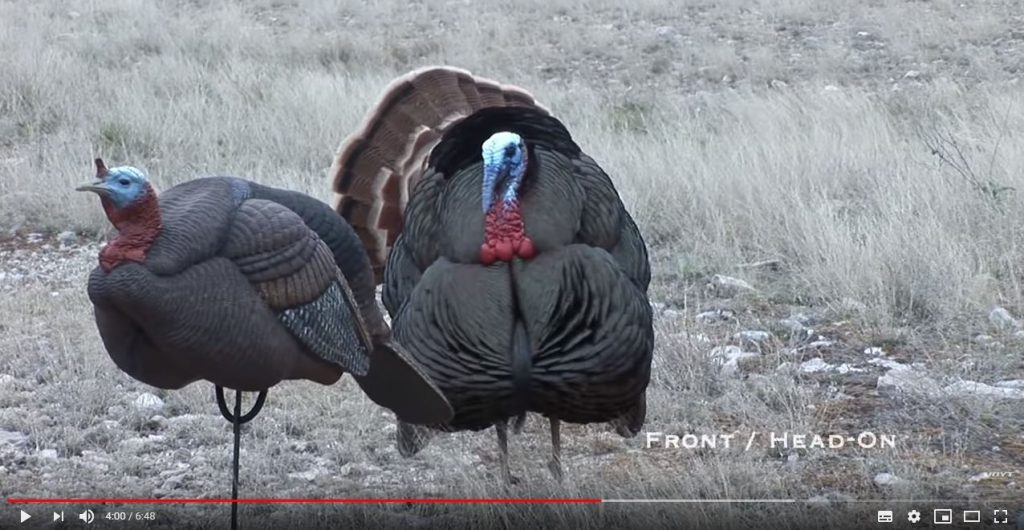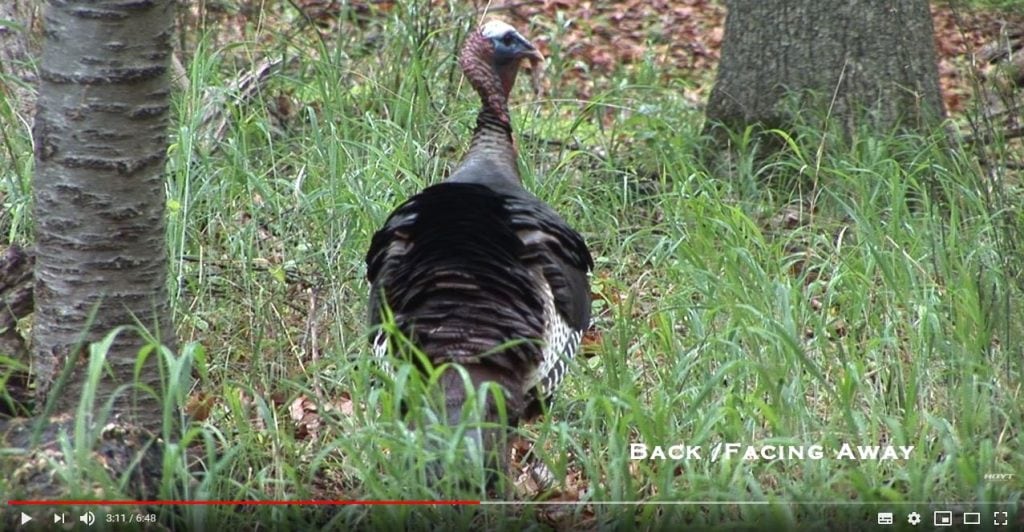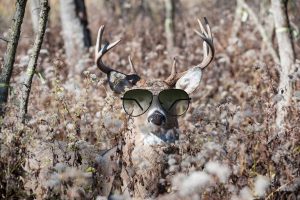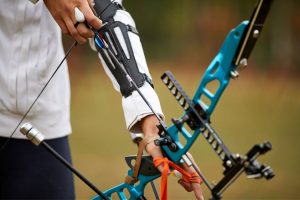There is something absolutely magnificent about listening to turkeys gobbling from their roost as the sun appears above the horizon on a crisp, cool spring morning. Anticipation runs rampant as one by one, turkeys depart from their roost trees and begin to forage about.
With any luck, you will soon be presented with the shot opportunity that you long for.
Contents (Jump to Topic)
However, despite a well thought out strategy, and a superb turkey calling, if you do not have an adequate understanding of where to shoot a turkey, you will be leaving the field empty-handed.
Best Places Where To Shoot A Turkey With A Bow are:
- Wing Butt
- Head/Neck Shot
- Base Of Beard
- Between Wings At The Back
- Base Of The Tail Feathers
Understanding Turkey Anatomy
A turkey is a hearty bird that can withstand far more than most hunters are aware of. To anchor a turkey with a single shot, your arrow placement must be spot on.
If your arrow misses its mark by only a few inches, it is highly likely that you will be forced to watch in disbelief as the turkey in question flies away as if they were never hit.
The most common cause for lengthy tracking jobs when turkey hunting is a lack of awareness as to where a turkey’s vitals are situated within the body cavity.
This is an easy mistake to make, as a turkey’s anatomy is arranged in a way that is somewhat different in relation to that of other frequently hunted game animals.
While many game species such as deer and elk have a vital zone that encompasses most of their chest and extends ⅓ – ½ way along the length of their body, a turkey’s vital organs are contained in a much more compact area, and reside high within the body cavity.
This provides a relatively small mark for an archer’s arrow to hit.
Unless contact is made in the hip joint region, a low-forward body hit seldom immobilizes a turkey.
When hit in this portion of the body, it is common for a turkey to flee by foot or flight. This makes tracking extremely difficult, to say the least.
Best Possible Arrow Placement
When shooting a turkey with archery equipment, there are several different shots, at varying angles that can be taken. However, two such options stand out above the rest in their ability to take any turkey quickly and ethically.
Wing-Butt (Broadside Angle)

One of the most effective choices of shot placement when attempting to take a turkey with archery equipment is at the wing-butt, where the wing itself joins the body. This is the shot of choice when a turkey is standing broadside to your position.
Wing-butt shot placement is a popular choice among archery hunters because of the arrow’s ability to immobilize a turkey, while simultaneously penetrating the vitals.
A turkey’s most common response, when startled, is to fly in the opposite direction from the location that they perceived the disturbance to have originated from. A wing-butt shot eliminates this possibility.
When an arrow makes contact with the wing-butt itself, this joint is typically separated, or a turkey’s wings become pinned, thereby making flight impossible.
This allows a turkey to expire rapidly in the same location where they were standing upon the shot being taken. A properly placed shot of this variety seldom requires any tracking to be conducted.
Head/Neck-Shot (Any Standing Angle)
Another form of shot placement that continues to grow in popularity and is also highly effective, is that of the head-shot. A head/neck-shot can be taken at virtually any angle when a turkey is in the standing position with their head up.
The reason that many archers find this form of shot placement to be so favorable is due to it being a kill or clean-miss kind of proposition.
Most archers who plan for head/neck-shots use expandable broadheads, and when this shot is taken, a turkey will either fall dead on the spot or be left untouched.
This virtually eliminates any possibility of a wounded turkey escaping.
Bowhunters also find this form of turkey shot placement to be highly effective for much of the same reason that shotgun hunters aim for the head and neck region. Any trauma to this portion of a turkey’s body causes rapid blood loss and disables motor functions due to spinal damage.
Read our guide about the turkey hunting gear essentials here
Alternate Forms Of Shot Placement
Though the two above mentioned forms of shot placement are among the most highly regarded options, there are several other varieties of shot placement that any bowhunter should be aware of.
Each of these individual forms has its own advantages, as well as times when they become the most favorable option.
Base Of Beard (Head On Angle)

Another form of shot placement that can be quite lethal when properly executed is aiming at the base of a turkey’s beard. This is a shot that is to be taken when a turkey is facing directly toward you, and will not present a broadside shot.
This is also a popular option when a turkey will not come out of strut to expose their head and neck.
Between Wings At The Back (Upright Away Facing Angle)
This is another potent form of shot placement that typically results in rapid death. If a turkey is facing directly away from you while standing upright, you can aim for a point that is directly between where each wing naturally meets the body at a turkey’s back.
This location can be found approximately ⅓ of the way down a turkey’s back, in a dead center location.
Base Of The Tail Feathers (Strutting Away Facing Angle)

This is the perfect shot placement to capitalize on when a turkey will not come out of strut and is headed directly away from you, quickly exiting your effective shooting range. In these situations, a shot must be taken while the opportunity still exists.
Aim dead center, directly at the base of a strutting turkey’s tail feathers. This will be in relatively close proximity to the anus.
For additional information regarding turkey shot placement, check out this quick video.
What To Do When A Shot Doesn’t Go As Planned
Despite our best efforts, we all occasionally experience times when our shot placement does not end up as intended. In this case, we often watch as the turkey we have shot runs or flies away.
This can be quite disheartening, but anyone that bowhunts for turkey long enough will be faced with a situation of this nature.
Though the prospect of recovering your turkey can seem quite bleak in this scenario, you can increase your odds of a favorable outcome by keeping these key considerations in mind.
- Earmark The Last Sighting: The first, and quite possibly most important step to recovering a poorly shot turkey is to notate exactly where you last saw the bird in question. This allows you to cover ground quickly by proceeding to that location. It can be wise to mark a tree or landmark with reflective tape so that you can return to it, should the trail go cold.
- Search For Blood High and Low: Blood trailing a turkey can be very difficult, as a turkey’s feathers can impede the flow of blood to the ground. This often leads to sporadic blood trails that are nearly impossible to follow. However, by following any blood while on your hands and knees, as well as looking for blood on brush situated at body height, you enhance your chances significantly.
- Look For Dislodged Feathers: Even in the absence of a notable blood trail, it is still possible to track a wounded turkey by looking for signs of feather loss. When a turkey is shot with an arrow, feathers are cut and become dislodged. As this turkey travels, pieces of these feathers fall to the ground below. Look carefully for small pieces of feathers, and mark their presence along the trail.
- Be Ready For A Follow-Up Shot: Always have your bow at the ready when tracking a wounded turkey. If you do happen to cross paths with the wounded bird, it is unlikely that you will have much time to place a follow-up shot. Any opportunity must be seized upon quickly.
Making Your Shot Count
By knowing where to shoot a turkey, you will be well equipped to seize upon the moment of truth when it arises.
As a beautiful spring gobbler struts into range, take your time, analyze the situation at hand, and choose the best possible shot placement for the particular scenario.
If your shot is steady and your arrow true, you will soon be packing your prize from the spring woods.






